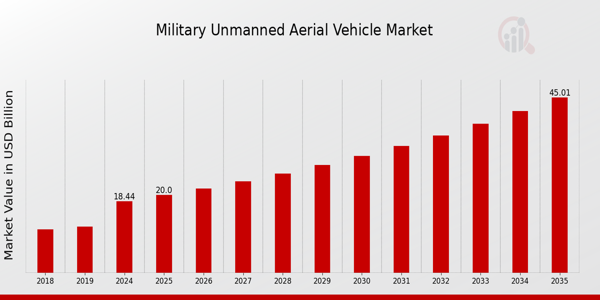Why Is the Demand for Military UAVs Soaring Toward USD 45 Billion by 2035?

Military Unmanned Aerial Vehicle Market Outlook
In today’s rapidly evolving defense landscape, military unmanned aerial vehicles (UAVs) have become indispensable assets for armed forces across the globe. Once considered auxiliary reconnaissance tools, UAVs are now central to modern military strategies, offering real-time intelligence, precision strike capabilities, and mission versatility with reduced human risk. According to recent market research by Market Research Future, the Military UAV Market is expected to grow from USD 18.44 billion in 2024 to USD 45 billion by 2035, reflecting a robust compound annual growth rate (CAGR) over the forecast period.
Market Overview: The Rise of Military UAVs
The increased adoption of UAVs in defense applications is reshaping the structure of modern military operations. From border surveillance to high-altitude strategic reconnaissance, drones have proved their worth across various terrains and combat situations. The market's expansion is being propelled by multiple factors, including geopolitical tensions, technological innovation, and government investments in autonomous defense systems.
North America, led by the United States, holds a dominant position in this sector due to its long-standing investment in Military Unmanned Aerial Vehicle technology, combat experience, and advanced manufacturing capabilities. However, regions such as Asia-Pacific and the Middle East are rapidly catching up, driven by regional security concerns and increasing defense budgets.
Key Drivers of Growth
- Growing Demand for ISR Capabilities
Intelligence, Surveillance, and Reconnaissance (ISR) missions form the backbone of modern military planning. UAVs are capable of conducting long-duration ISR operations with precision, offering a cost-effective and safer alternative to manned missions. As nations emphasize situational awareness and real-time data collection, the demand for UAVs with advanced sensor payloads is on the rise. - Technological Advancements
The integration of AI, machine learning, and autonomous navigation systems has revolutionized UAV operations. Today's military drones can operate in GPS-denied environments, make autonomous decisions in combat zones, and coordinate with manned aircraft seamlessly. Moreover, innovations in battery technology, lightweight materials, and miniaturization of components are boosting UAV performance and range. - Reduced Operational Costs and Human Risk
One of the most appealing aspects of UAVs is the reduction of human exposure in dangerous missions. With drones taking over reconnaissance, strike, and logistic roles, armed forces can protect personnel while maintaining strategic effectiveness. Additionally, drones are often more cost-effective than traditional manned aircraft in both procurement and operation. - Increased Cross-Border Conflicts and Security Threats
The escalation of border tensions, terrorism, and asymmetric warfare across regions is further pushing nations to invest in unmanned systems. UAVs offer flexibility, stealth, and rapid deployment, making them ideal for both surveillance and targeted strikes in hostile areas.
Market Segmentation Insights
The Military UAV Market can be segmented based on type, range, mode of operation, technology, and payload.
- By Type: Fixed-wing UAVs dominate the segment due to their longer endurance and range, making them ideal for surveillance and reconnaissance. However, rotary-wing and hybrid UAVs are gaining traction for their maneuverability in close combat and urban environments.
- By Range: Medium-altitude long-endurance (MALE) and high-altitude long-endurance (HALE) UAVs are particularly in demand for their persistent ISR capabilities across strategic zones.
- By Mode of Operation: Autonomous UAVs are witnessing growing preference over remotely piloted ones, thanks to advancements in AI and autonomous navigation systems.
- By Technology: The integration of stealth technologies, jam-resistant communication systems, and real-time data processing is becoming standard, especially among developed defense forces.
- By Payload: UAVs equipped with electro-optic/infrared (EO/IR) sensors, radar systems, electronic warfare packages, and precision-guided munitions are witnessing increased demand, allowing multi-mission roles from a single platform.
Regional Landscape
- North America: With its large defense budget and strong R&D infrastructure, the U.S. remains a key innovator and exporter of military UAVs.
- Europe: The region is seeing rising investments due to NATO initiatives and individual country programs like the European MALE UAV project.
- Asia-Pacific: Nations such as China, India, South Korea, and Japan are expanding their UAV fleets for both defensive and offensive capabilities.
- Middle East & Africa: Driven by persistent conflict zones, regional players are investing heavily in tactical UAVs for surveillance and precision strikes.
Competitive Landscape
The market is moderately consolidated, with key players focusing on strategic collaborations, acquisitions, and technological upgrades. Prominent companies include:
- Northrop Grumman Corporation
- General Atomics Aeronautical Systems
- Elbit Systems Ltd.
- BAE Systems
- Israel Aerospace Industries (IAI)
- Airbus S.A.S.
- Boeing Defense, Space & Security
These companies are engaged in developing next-gen UAVs with extended endurance, stealth capabilities, and multi-role flexibility.
Get a Quote - Request a price quote for the report or specific research services:
Looking Ahead: The Future of Military UAVs
As the battlefield becomes more digitized and autonomous, military UAVs will play a critical role in shaping defense doctrines. The market's projected growth to USD 45 billion by 2035 underscores the rising strategic importance of these systems. Future developments are expected to focus on swarm UAVs, AI-driven mission autonomy, and integration with satellite and cyber-defense systems.
The trajectory of the military UAV market clearly indicates a shift toward more agile, responsive, and intelligent warfare – where drones are no longer just eyes in the sky, but vital decision-makers on the battlefield.
- Art
- Causes
- Crafts
- Dance
- Drinks
- Film
- Fitness
- Food
- Games
- Gardening
- Health
- Home
- Literature
- Music
- Networking
- Other
- Party
- Religion
- Shopping
- Sports
- Theater
- Wellness


